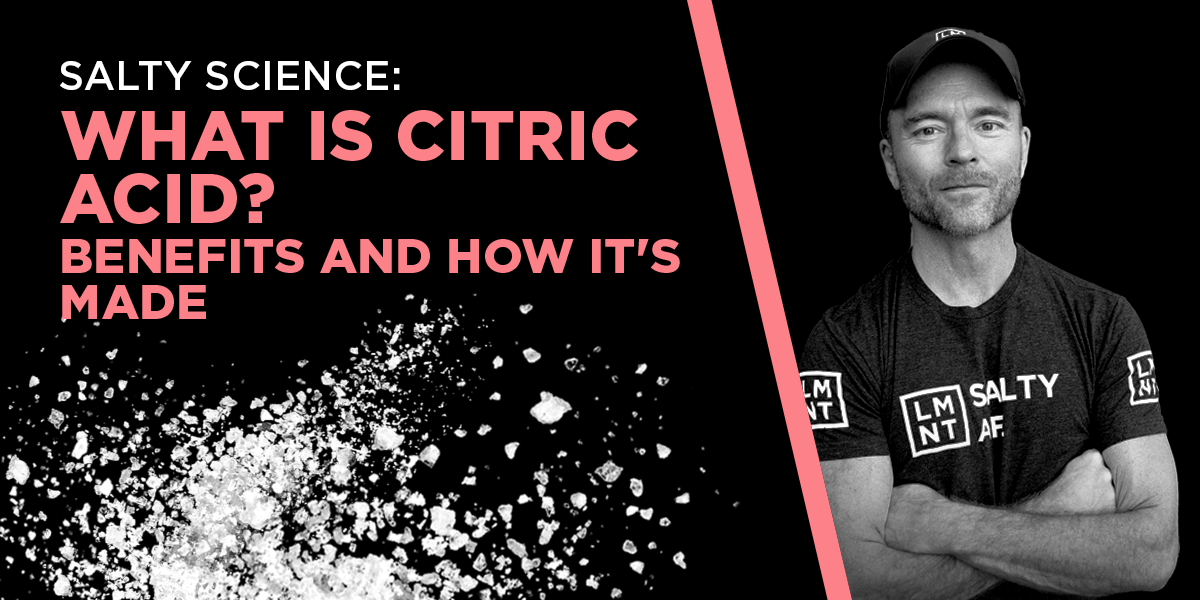If you’ve read an ingredients label lately, you’ve probably seen citric acid appear on the label. You might have wondered, what is it?
You’re not alone in your musings. My inbox proves it. A quick tally reveals that while some folks are curious about citric acid, others are downright concerned. My goal with this article is to explain what citric acid is and how it impacts our health.
As a primer, citric acid is a natural molecule (C6H8O7) found mostly in citrus fruits. Its mass-produced form (same molecule) is used to flavor and enhance thousands of products.
To produce citric acid, food manufacturers rely heavily on a fungus called aspergillus niger because it delivers the same nutrient profile at a significantly reduced cost for consumers. Some folks hear “fungus” and are immediately concerned, but not all fungi are bad for our health. Case in point: I’ve never seen anyone run at the sight of a shiitake mushroom. Still, I’ll address these concerns later in the article.
Full disclosure, we use citric acid in LMNT—our electrolyte drink mix—to create its refreshing and fruity taste profile. If I were concerned about citric acid, I wouldn’t be feeding it to you, myself, my wife, or my kids. Quite the opposite, citric acid even has health benefits. But if you’re still worried, our Raw Unflavored LMNT doesn’t contain citric acid.
I wrote this post to provide a complete rundown on citric acid. You’ll learn how it’s made, where it’s used, benefits, and potential downsides. Then you can decide if citric acid is worth worrying about.
What Is Citric Acid?
As we discovered above, citric acid is a naturally occurring organic acid, found mostly in citrus fruits.
A wide array of products contain citric acid. It adds acidity, prevents microbes from growing, and provides a sour, tangy taste.
Citric acid is no stranger to the human body. For every kilogram of bodyweight, there’s about 1 milligram of citric acid in your blood. Citric acid helps you convert food energy into cellular energy via a process called… wait for it… the citric acid cycle.
Along with its role in energy production, citric acid enhances calcium, phosphorous, and magnesium absorption through the gut. The same mineral-binding property helps prevent calcium crystals (the most common type of kidney stones) from forming.
History and Production of Citric Acid
Citric acid was discovered in 1784 by an English scientist named William Scheele. He found it in lemon juice.
Fast forward to 1917, and the American chemist James Currie made the biggest discovery of his career. He fed sugar to a strain of fungus and—boom—out popped loads of citric acid. Compared to extracting citric acid from fruit, Currie’s method was cheaper and more efficient.
Today, the industry pumps out over 2 million tons of citric acid every year. Big business, yes, but remember: Mass-produced citric acid is still the same molecule (C6H8O7) that’s in lemons and limes. Let me say that again: Mass-produced citric acid is still the same molecule (C6H8O7) that’s in lemons and limes.
Citric acid production isn’t that complicated. You provide aspergillus niger a sugary substrate (dextrose), then go get your afternoon workout in while it ferments. Citric acid is a byproduct of this process in the same way that oxygen is a byproduct of photosynthesis. After fermentation, the citric acid is separated and purified to be used in food products.
Products Containing Citric Acid
Food-wise, you find citric acid in:
- Citrus Fruits
- Soda
- Juice
- Candy
- Frozen foods
- Ice cream
- Many other foods that come in a package
I often wonder if people have bad associations with citric acid because it’s in so many crappy foods, kind of like how sodium gets a bad rap because folks tend to consume it heavily through highly processed and refined foods. We should focus on eliminating crappy foods from our diet, not demonizing specific nutrients.
Of course, you can also consume citric acid by sucking down citrus fruits. One liter of lemon juice, for instance, contains 48 grams of citric acid—an amount far exceeding what you find in manufactured foods. (For context, 1 ounce of lemon juice contains 1.5 grams of citric acid – approximately the same amount as 1 packet of flavored LMNT)
Benefits Of Citric Acid
Although citric acid’s primary reason for being included in packaged foods is typically for flavoring, it’s even been associated with a number of health benefits. Here are three of them:
#1: Enhanced Mineral Absorption
You’ve probably seen dietary supplements in citrate form. Potassium citrate, magnesium citrate, and calcium citrate are three of the most common.
This formulation isn’t an accident. Citrate—what we call citric acid when bonded to ions like calcium, magnesium, etc.—enhances a mineral’s bioavailability. In other words, you absorb it better.
The same holds true for citric acid. Let me share a few examples from the literature:
- When young men drank sudachi juice (high in citric acid) along with a high calcium seafood dish, they absorbed and retained more calcium, phosphorus, and magnesium than non-sudachi controls.
- Rats fed citric acid absorbed more calcium and phosphorus into their bones.
- Citric acid in human breast milk increases iron absorption.
We included citric acid in LMNT for both flavor and its ability to boost mineral absorption.
#2: Kidney Health
You just learned how citric acid binds to calcium and helps it enter bone. This calcium-binding action also stops calcium from crystallizing.
This is good news for your kidneys because kidney stones are made of crystallized calcium. Inhibit the crystallization process and you help inhibit the stones from forming. Low blood citrate, in fact, is a significant risk factor for developing kidney stones.
Moving on to clinical trials, one seven-study review found that citrate therapy reduced the stone size (and new stone formation in certain folks) vs. placebo. According to the authors, however, the quality of the evidence wasn’t exactly grade A.
As a counterpoint, another study found no effect of citric acid supplementation on urinary markers of kidney stone risk. The takeaway? Consult your doctor if you have kidney stones. More research is needed before recommending citric acid.
#3: Energy Production
Adenosine triphosphate (ATP) is probably the most important molecule in your body. It’s the currency of energy. It powers your muscles, nerves, and everything else that keeps you going.
How do you make ATP? That’s right, through the citric acid cycle. (Side note: the citric acid cycle is also known as the TCA cycle or the Krebs cycle.)
I will not be posting a diagram of the citric acid cycle here. If you google it, you will quickly realize why I spared you the trouble. To keep things simple, just understand that citric acid is an integral link in the ATP-production chain.
But citric acid isn’t just a link in the chain. It’s also an activator. Yes, citric acid activates the TCA cycle like baked cinnamon activates the salivary glands. Mmm, cinnamon.
There’s clinical evidence for this activating effect. In one randomized controlled trial, 18 people were given either citric acid (2.7 grams / day), l-carnitine (1 gram / day), or placebo. Compared to both carnitine and placebo, citric acid:
- Reduced salivary levels of chromogranin A (a marker of physical stress)
- Decreased subjective fatigue
Basically, citric acid outperformed l-carnitine, which is often touted as an energy-boosting supplement. Super interesting stuff.
Citric Acid Side Effects
Citric acid is generally recognized as safe (GRAS) by the FDA. As far as dangers go, avoid inhaling citric acid or getting it in your eye. It can damage lung and ocular tissue.
Lingering concerns also remain about aspergillus niger, the fungus that supplies 99% of the world’s manufactured citric acid. Aspergillus niger produces a myotoxin called ochratoxin A, which appears to cause lung disease when inhaled by immunocompromised patients. A 2002 peer-reviewed analysis, however, deemed the fungus to be “a safe production organism.”
To be clear, manufactured citric acid should not contain aspergillus niger, as it is meticulously filtered out. Still, some researchers are concerned that traces of the mold remain. They speculate these mold traces, if ingested, could cause health issues.
But even these researchers admit that their evidence isn’t top shelf. It only consists of four case reports: a few folks reporting inflammation, joint pain, and stomach issues in the context of variable diets.
Is Citric Acid Healthy?
If you’re like a label-reader like me, it’s important that you’re familiar with everything on the ingredient list. Let’s review the highlights on citric acid.
Citric acid:
- Occurs naturally in citrus fruits and the human body
- Is produced by aspergillus niger, a highly useful fungus that is thoroughly filtered out during the production process
- Shows up in food as a flavoring, preservative, antimicrobial, acidifier, chelator, and more
- Improves mineral absorption, energy production, and may help with kidney stones
- Appears to be very safe for human consumption
All things considered, I’m confident in citric acid. I wouldn’t use it in my electrolyte drink mix otherwise. That said, I acknowledge there is a massive spectrum of how folks respond to any given substance. So as it relates to LMNT, if you really want to avoid citric acid you can always turn to the Raw Unflavored version to address your electrolyte needs.
I hope this post answered all your questions about citric acid! Thank you taking the time to read it. And if you’re interested, check out this article on malic acid next. It’s an interesting read!

